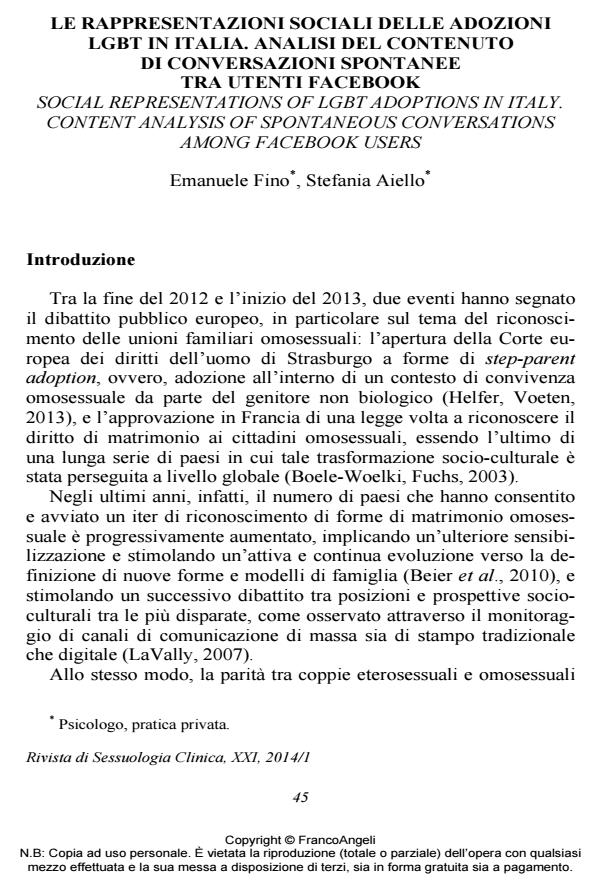Social representations of LGBT adoptions in Italy. Content analysis of spontaneous conversations among facebook users
Journal title RIVISTA DI SESSUOLOGIA CLINICA
Author/s Emanuele Fino, Stefania Aiello
Publishing Year 2014 Issue 2014/1
Language Italian Pages 22 P. 45-66 File size 113 KB
DOI 10.3280/RSC2014-001003
DOI is like a bar code for intellectual property: to have more infomation
click here
Below, you can see the article first page
If you want to buy this article in PDF format, you can do it, following the instructions to buy download credits

FrancoAngeli is member of Publishers International Linking Association, Inc (PILA), a not-for-profit association which run the CrossRef service enabling links to and from online scholarly content.
In the last decade, countries ruling on LGBT marriage and adoption have been increasing, stimulating a public discussion observed in traditional and new media. The Italian public debate has been influenced by cultural and legal transformations occurring in the near European nations, although cultural and religious oppositions contributed to stop the process of legalization of LGBT unions and parenthood. In the present study, the authors investigate the representations of LGBT adoption emerging from a corpus Facebook spontaneous conversations. Text thematic clustering and similarity analysis were applied. The emerging four clusters showed the effort of negotiation of traditional and stereotypical family roles and related socio-cultural expectations, towards the definition of a new image of family.
Keywords: Social representations, adoptions, LGBT, facebook, thematic analysis, similitude analysis.
- Factor Structure and Psychometric Properties of the Italian Version of the Homosexuality Scale of the Trueblood Sexual Attitudes Questionnaire Emanuele Fino, Marta Giuliani, Luca Pierleoni, Gaetano Gambino, Valentina Cosmi, Chiara Simonelli, in Journal of Homosexuality /2018 pp.784
DOI: 10.1080/00918369.2017.1364558 - Atteggiamenti verso il matrimonio e il parenting di persone lesbiche e gay: correlazione con sessismo, omofobia e stigma sessuale interiorizzato Francesca Aversa, Francesca Tripodi, Filippo Maria Nimbi, Roberto Baiocco, Chiara Simonelli, in RIVISTA DI SESSUOLOGIA CLINICA 1/2017 pp.48
DOI: 10.3280/RSC2017-001003
Emanuele Fino, Stefania Aiello, Le rappresentazioni sociali delle adozioni LGBT in Italia. Analisi del contenuto di conversazioni spontanee tra utenti facebook in "RIVISTA DI SESSUOLOGIA CLINICA" 1/2014, pp 45-66, DOI: 10.3280/RSC2014-001003